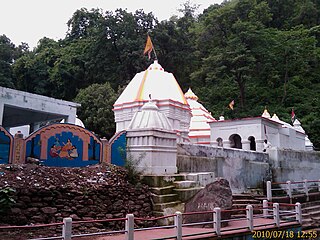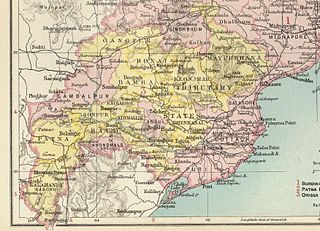
Balangir District, also called Bolangir District, is a district situated in Odisha state of India. The district has an area of 6,575 km2 (2,539 sq mi), and a population of 1,648,997. The town of Balangir is the district headquarters. The composition of the land is predominantly rural. Other important big & small towns in Balangir district are Titlagarh, Patnagarh, Kantabanji, Loisingha, Saintala, Belpada, Tushra, Agalpur, Deogaon, Chudapali, Biripali, Bhalumunda, Bangomunda, Sindhekela, Kansil, Turekela and Muribahal.

Gajapati district is a district of Odisha State in India. It was carved out of Ganjam District on 2 October, 1992. As of 2011 it is the third least populous district of Odisha, after Debagarh and Boudh. Gajapati district was named after Krushna Chandra Gajapati Narayan Deb, the King of the Paralakhemundi estate and the first Prime Minister of Orissa, who is remembered for his contribution to the formation of a separate state, and inclusion of his estate in Odisha. The district headquarters at Paralakhemundi, formerly a Zamindari, has been clustered within a radius of approximately 5 kilometers around the geometric centre of Paralakhemundi.

Angul district; also known as Anugul, is one of the thirty districts of Odisha in eastern India. The city of Angul is the district headquarters of Angul district. A major industrial hub of the state, the district hosts numerous industries relating to coal, bauxite and steel apart from extensive forests including the Satkosia Tiger Reserve.

Debagarh District also known as Deogarh District is a district of Odisha state, India. Located in the north-western part of the state, it is one of Odisha's 30 administrative districts and has its headquarters at Debagarh (Deogarh) town.

Bamra State or Bamanda State, covering an area of 5,149 km2, was one of the princely states of India during the British Raj. Its capital was in Debagarh (Deogarh). Bamra State acceded to India in 1948.

The Eastern States Agency was an agency or grouping of princely states in eastern India, during the latter years of the British Raj. It was created in 1933, by the unification of the former Chhattisgarh States Agency and the Orissa States Agency; the agencies remained intact within the grouping. In 1936, the Bengal States Agency was added.

Boudh District is an administrative and municipal district, one of thirty in the Odisha, India. The district headquarters is the city of Boudh.
Debagarh, also known as Deogarh, is a city in Odisha state of eastern India. Located in the North-Western region of the state, it is the headquarters of Debagarh District that was created on 1 January 1994, after being bifurcated from Sambalpur District.

The Orissa Tributary States, also known as the Gadajats (ଗଡ଼ଜାତ) and as the Orissa Feudatory States, were a group of princely states of British India now part of the present-day Indian state of Odisha.

Dhenkanal State was one of the princely states of India during the period of the British Raj. The area of the former state is now referred to as Dhenkanal district, Odisha, with Dhenkanal town as its district headquarters.
Western Odisha is the western part of the state of Odisha in India, extending from the Kalahandi district in the south to the Sundargarh district in the north.

The Eastern Ganga dynasty were a large medieval era Indian royal Hindu dynasty that reigned from Kalinga from as early as the 5th century to the mid 20th century. Eastern Gangas ruled much of the modern region of Odisha in three different phases by the passage of time, known as Early Eastern Gangas (493–1077), Imperial Eastern Gangas (1077–1436) and Khemundi Gangas (1436–1947). They are known as "Eastern Gangas" to distinguish them from the Western Gangas who ruled over Karnataka. The territory ruled by the dynasty consisted of the whole of the modern-day Indian state of Odisha, as well as major parts of north Andhra Pradesh, parts of Chhattisgarh and some southern districts of West Bengal. Odia language got official status in their regime following the evolution of the language from Odra Prakrit. The early rulers of the dynasty ruled from Dantapuram; the capital was later moved to Kalinganagara, and ultimately to Kataka and then to Paralakhemundi.

Dharakot is a semi-urban village and former zamindari estate in Dharakot Community Development Block of Ganjam district in the Indian state of Odisha.

The Raikut family was a princely family that controlled large estates in Jalpaiguri what is now West Bengal, India, first as subjects to the state of Koch Bihar, later as Zamindars to the Mughal rulers of Bengal, and then to British Raj. Their story parallels that of the Bardhaman Raj, from the same region.
Deogarh is a Vidhan Sabha constituency of Debagarh district.

Rairakhol State was a minor princely state during the British Raj in India. It was one of the Chota Nagpur States and had its capital at Rairakhol (Redhakhol), located in the present-day Sambalpur district of Odisha. It had an area of 2,157 square kilometres (833 sq mi) and a population of 26,888 in 1901. The average revenue was Rs. 55,000 in 1904.
Hetkhamar is a village in Debagarh district, Odisha, about 35 kilometers from the district headquarters Debagarh.
The Puri Estate was an estate ruled by the main branch of the Bhoi dynasty, who were reinstated in Puri in 1809 following the 1804 rebellion against the British and annexation of the Khurda Kingdom which were under their control. After the rebellion led by the Khurda king, Mukunda Deva II, the British decided to take control of the administration of the Khurda kingdom and Mukunda Deva II was exiled to Cuttack and Mindapore but was later reinstated and pensioned off to Puri to remain as a titular head of the dynasty while retaining control over the Jagannath Temple.
Bamra, also referred to as Bamanda was a constituency of the Odisha Legislative Assembly, of the Sambalpur district, Odisha state in India. It was formed in 1951 and was abolished in 1957. It was replaced by the constituencies of Deogarh and Jarsuguda.












